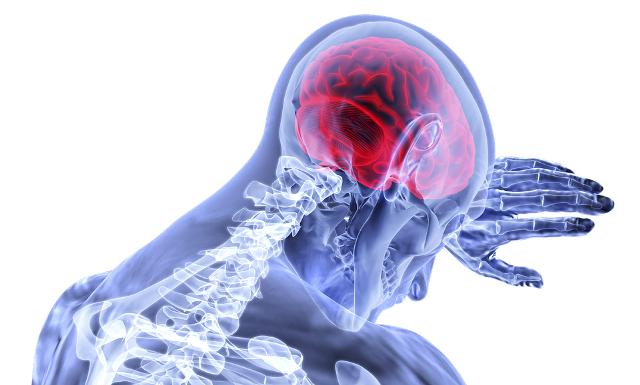Part of the Brain That Kills Pain Can Provide Alternative To Opioid
Hello, amazing reader and steemian;
I’d like to write about “pain” today. Pain is a feeling that almost everyone reading this must have gone through at one point or the other. In fact, some people get to experience pain every single day – due to ill health or through one form of deformation or the other.
What is pain, in layman’s terms?
Pain is an integral part of human biology. Asides humans, almost all other living organism on the planet feel pain. I say almost because, there have been recent, proven and verified cases of people (a family) with genetic mutations which inhibits pain sensors, making them unable to feel pain.

Such cases of “pain-less feeling people” are quite rare, and they aren't always your next door neighbour’s – in case you were wondering. The rarity of such a phenomenon easily creates a "biological divide", due to the fact that one of the properties or characteristics of living things is the feature of “responding to stimuli”.
Fundamental biology teaches us that living things have neurons which carry signals to and from the brain, to indicate the exact stimuli our body is experiencing and responding to, in our immediate environment. Pain is one of such stimuli, and as such, humans and living things are normally supposed to experience it. Hence, the rare nature of the family that feels no pain remains what it is – a rarity.
What is the biological implication of pain?
Pain according to biology is a mechanism, because it informs us of when things are wrong with the body, and thereby forces us to become inactive in order to enable energy get diverted for healing to commence.
There are other times when pain can become counter-effective in a way that it hinders a person’s ability to help themselves. When this happens the brain effectively turns down pain signals so that the person can find relief.
Opioid painkillers have been assisting with pain. But a new research shows great promise
The exact location in the brain where the natural painkilling system is controlled from, has been identified through a new research. Before now, Opioid which is somewhat of a narcotic pain-killer, has been used in various Health organisations as a medication, but cases of addiction and overdose have generated reactions causing public health emergencies.

Studies into alternative methods of treating and managing pain has led scientists at the University of Cambridge to research on various means of pain control, such as tricking the body’s pain-signalling-channels on injury spots, to investigating the genetic makeup of people who feel no pain.
The new study by the scientists aims to understand how the brain regulates and modulates the degree of pain felt throughout the body via the endogenous analgesia system which “turns down” pain signals.
The first experiment of the study involved heat
Lead researcher on the project, Ben Seymour, said;
"We're trying to understand exactly what the endogenous analgesia system is: why we have it, how it works and where it is controlled in the brain.
From the first experiment, volunteers were subjected to painful heat from an external source on their arm. To reduce the pain being felt, the procedure required them to play a game and aim to press a particular button. The game’s difficulty level varied and the research subjects constantly rated their pain levels while their brain activity was being monitored.
The result form the experiment showed that people who were actively working to target the right button had lower levels of pain, while the pain levels were not reduced when the subject knew the exact button to touch.
What it implies is that the degree of pain being felt was modified by a part of the brain, based on how active the person feeling the pain is working to find solution to reduce the source of the pain.
The second experiment of the study was target oriented
Next on the research agenda was to identify the exact location or part of the brain where the pain-modulating signals originate. The scientists were able to identify the small part of the prefrontal cortex (the pregenual cingulate cortex) as the very specific source.
According to Ben Seymour, the result from the study showcases the picture of how and why the brain decides to turn off pain under certain circumstances, and how the pregenual cingulate cortex is the main controller of pain in the body.
Conclusion
The high point of this new study is that if the "critical decision centre" can be figured out completely, the discovery would aid selective pain treatments, to guarantee effectiveness of pain management and treatment.
The overall conclusion is that the 'pregenual cingulate cortex' is the part of the brain that temporarily reduces the feeling of pain in situations where the pain is preventing the person from successfully doing something which could help reduce the pain.
The group of researchers are currently pushing for further understanding of what inputs or reactions actually activate these part of the brain, and whether it can be stimulated artificially or externally. Such knowledge once understood, would aid the development of new treatment alternatives for sufferers of chronic pains.
Image Source: Pixabay
Resource:
- elifesciences.org
- opioid
- sciencedaily.com
- genetic mutation family feel no pain
- pain control rna decoy molecule
- cam.ac.uk
Thank you for your time and for reading my post. If you found this post interesting, then kindly UPVOTE, RESTEEM and FOLLOW @rickie, for more quality posts.
You Can Check Out My Other Posts Below:
- Daffodils - The New Battle Axe Against Cancer
- Illegal Animal Poachers Are In Trouble; As New Artificial Intelligence Is Set To Screw Them Up
- The Vision of Praying Mantis Can Inspire Simpler Vision-Processing For Robots
- Undiscovered and Unknown Viruses Can Now Be Hunted To End Global Viral Pandemic
- A Device For Administering Drug Directly To The Brain Is To Become Neurological Game-Changer
- Science Says Casual Sex is Freaking Healthy, So Do It

@rickie
- pain control rna decoy molecule
Thanks for the valuable post. I think pain is that there is no upvote for your good content..
Lolz.....Thanks for reading @cemke. I do appreciate.